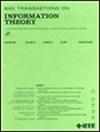Capacity Bounds for Broadcast Channels With Bidirectional Conferencing Decoders
IF 2.9
3区 计算机科学
Q3 COMPUTER SCIENCE, INFORMATION SYSTEMS
引用次数: 0
Abstract
The two-user broadcast channel (BC) with receivers connected by bidirectional cooperation links of finite capacities, known as conferencing decoders, is considered. A novel capacity region outer bound is established based on multiple applications of the Csiszár-Körner identity. Achievable rate regions are derived by using Marton’s coding as the transmission scheme, together with different combinations of decode-and-forward and quantize-bin-and-forward strategies at the receivers. It is shown that the outer bound coincides with the achievable rate region for a new class of semi-deterministic BCs with degraded message sets; for this class of channels, one-round cooperation is sufficient to achieve the capacity. Capacity result is also derived for a class of more capable semi-deterministic BCs with both common and private messages and one-sided conferencing. For the Gaussian BC with conferencing decoders, if the noises at the decoders are perfectly correlated (i.e., the correlation is either 1 or −1), the new outer bound yields exact capacity region for two cases: 1) BC with degraded message sets; 2) BC with one-sided conferencing from the weaker receiver to the stronger receiver. When the noises have arbitrary correlation, the outer bound is shown to be within half a bit from the capacity region for these same two cases. Finally, for the general Gaussian BC, a one-sided cooperation scheme based on decode-and-forward from the stronger receiver to the weaker receiver is shown to achieve the capacity region to within双向会议解码器广播信道的容量界限
考虑了由有限容量的双向合作链路连接的双用户广播信道(BC),即会议解码器。基于Csiszár-Körner恒等式的多重应用,建立了一种新的容量域外界。采用马尔顿编码作为传输方案,在接收端采用译码转发和量子化转发策略的不同组合,导出了可实现的速率区域。结果表明,对于一类具有降级消息集的半确定性bc,其外边界与可达到的速率区域重合;对于这类渠道,一轮合作就足以实现容量。对于具有公共消息和私有消息以及单边会议的一类更有能力的半确定性bc,还导出了容量结果。对于具有会议解码器的高斯BC,如果解码器处的噪声是完全相关的(即相关性为1或- 1),则新的外边界产生两种情况的精确容量区域:1)具有降级消息集的BC;2)从较弱的接收方到较强的接收方单向会议的BC。当噪声具有任意相关性时,表明这两种情况下的外界距离容量区域在半位以内。最后,对于一般高斯BC,给出了一种基于从强接收机到弱接收机的解码转发的单边合作方案,以实现到$\frac {1}{2}\log \left ({{\frac {2}{1-|\lambda |}}}\right)$位以内的容量区域,其中$\lambda $为噪声相关。这些结果的一个有趣的含义是,对于具有完全负相关噪声的高斯BC和具有有限合作链路容量的会议解码器,仅使用无限小的发射功率就可以实现严格的正速率。
本文章由计算机程序翻译,如有差异,请以英文原文为准。
求助全文
约1分钟内获得全文
求助全文
来源期刊

IEEE Transactions on Information Theory
工程技术-工程:电子与电气
CiteScore
5.70
自引率
20.00%
发文量
514
审稿时长
12 months
期刊介绍:
The IEEE Transactions on Information Theory is a journal that publishes theoretical and experimental papers concerned with the transmission, processing, and utilization of information. The boundaries of acceptable subject matter are intentionally not sharply delimited. Rather, it is hoped that as the focus of research activity changes, a flexible policy will permit this Transactions to follow suit. Current appropriate topics are best reflected by recent Tables of Contents; they are summarized in the titles of editorial areas that appear on the inside front cover.
 求助内容:
求助内容: 应助结果提醒方式:
应助结果提醒方式:


